A correlation matrix is a matrix that shows the correlation between variables. It gives the correlation between all the possible pairs of values in a matrix format.
What Is a Correlation Matrix?
A correlation matrix is a statistical technique used to evaluate the relationship between two variables in a data set. The matrix is a table in which every cell contains a correlation coefficient, where 1 is considered a strong positive relationship between variables, 0 is no relationship and -1 is a strong negative relationship. It’s most commonly used in building regression models.
We can use a correlation matrix to summarize a large data set and to identify patterns and make a decision according to it. We can also see which variable is more correlated to which variable, and we can visualize our results.
A correlation matrix involves a rows and columns table that shows the variables. Every cell in a matrix contains the correlation coefficient. The correlation matrix is in conjunction with other types of statistical analysis.
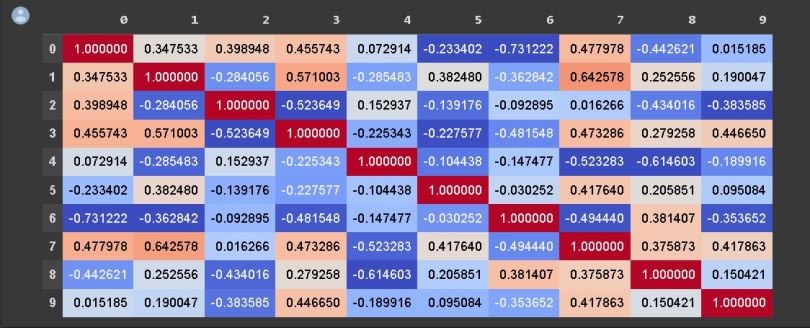
Using a correlation matrix is very useful for regression techniques like simple linear regression, multiple linear regression and lasso regression models. In the regression technique, we have several independent variables, and based on that, we are predicting the dependent variable.
In multiple linear regression, the correlation matrix determines the correlation coefficients between the independent variables of a model.
When Do You Use the Correlation Matrix?
The correlation matrix gives you an idea about your data set.
For example, let’s say you want to predict the price of a car on the basis of fuel type, transmission type or age, etc. A correlation matrix would be very useful.
Using a correlation matrix, we can evaluate the relationship between two variables:
- If the relationship is 1, then the relationship is positively strong.
- If the relationship is 0, then it means the relationship is weak or nonexistent.
- If the relationship is -1, then it means the relationship is negatively strong.
- By using a correlation matrix, you can better understand your data set, analyze it and visualize the result.
- Most data scientists consider the use of a correlation matrix as the main step before building any machine learning model because if you know which variables are correlated which, you can gain a better understanding about what’s most important for your model.
- The correlation matrix is a statistical technique that gives you the values between -1 to 1 which you can determine the relationship between variables.
Finding the Correlation Coefficient in a Correlation Matrix
Correlation Coefficient and Types
Before building a correlation matrix, you need to understand what a correlation coefficient is and its different types.
Correlation coefficients are used to determine how strong a relationship is between two variables.
There are several types of correlation coefficients. The most common ones used for correlation matrices are Pearson, Spearman’s rank and Kendall’s tau correlation coefficient.
Types of Correlation Coefficients:
- Pearson correlation coefficient (r) measures degree of linear relationship between two interval or ratio variables; also known as sample correlation coefficient when applied to sample data or population correlation coefficient when applied to population data.
- Spearman’s rank correlation coefficient or Spearman’s rho (ρ) measures degree of nonparametric relationship between two ordinal, interval or ratio variables; calculates based on difference in rank of the two variables.
- Kendall rank correlation coefficient or Kendall’s tau (τ) measures degree of nonparametric relationship between two ordinal, interval or ratio variables; calculates based on number of concordances and discordances in two paired variables.
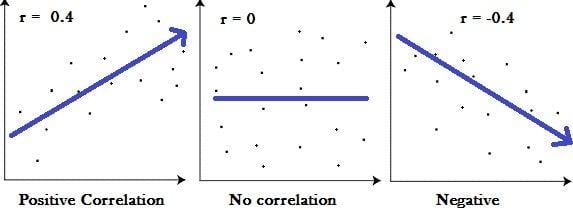
How to Calculate Correlation Coefficient
For example, let’s find the correlation coefficient of the given table:
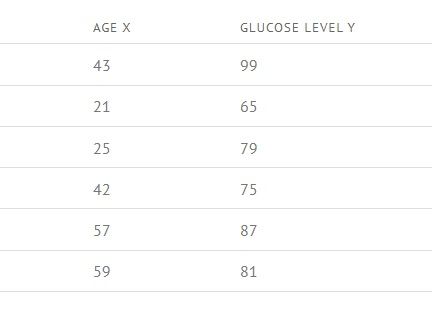
Step 1: Calculate AGE X * GLUCOSE LEVEL Y for each value in the table.
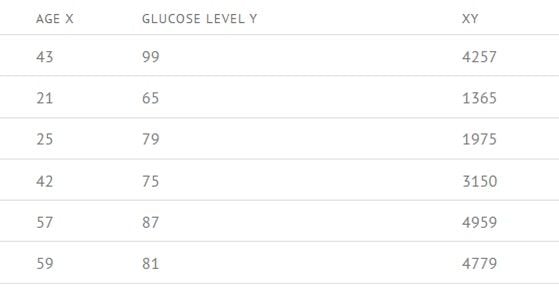
Step 2: Now calculate X2 and Y2 for each value in the table.
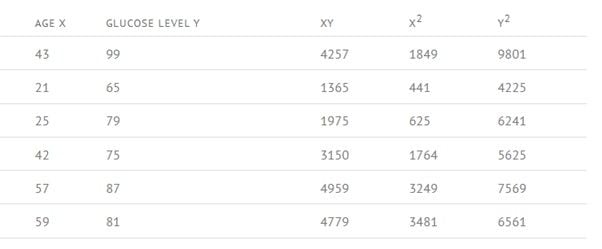
Step 3: Now calculate the sigma (Σ) for every column.
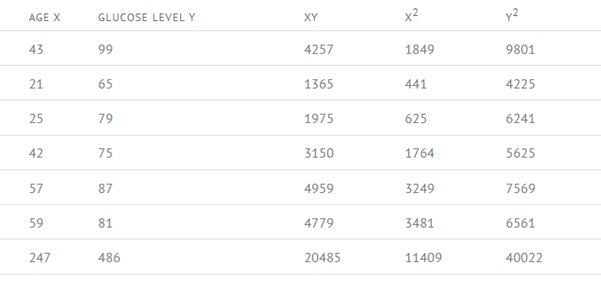
Step 4: Now we are going to use the Pearson correlation coefficient formula.

Values are: n = 6, Σxy = 20485, Σx = 247, Σy = 486, Σ = 11409, Σ = 40022, r = 0.5298……(from formula).
By putting values inside this formula, we can calculate how strong the relationship is between two variables. So, by entering those values, we get 0.5298, which means our relationship is greater than neutral and less than positive
That’s how we can calculate the correlation coefficient of each value and make a matrix from it.
Correlation Matrix Implementation in Python
We can easily implement a correlation matrix in Python because Python has a large library of support, and for statistical analysis, we can use Pandas and NumPy.
Most data analysts implement their correlation matrix in Python because Python has a powerful package that helps us to do data pre-pressing, and we can make great visualizations.
There are some certain steps you need to follow to implement the correlation matrix:
Step 1: Collect the Data From Various Sources

Collect the data from various sources for the correlation matrix. The following data is about three variables.
Step 2: Create a DataFrame of A, B, C Using Pandas
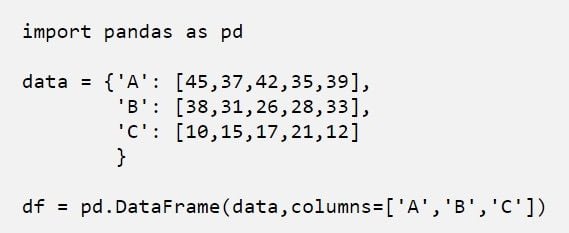
We’ve now created a DataFrame using Pandas. Now, we have three variables, A, B and C.
Step 3: Create a Correlation Matrix Using the “Corr” Function

Output:

By using the corr function we have created a correlation matrix that looks like the above image.
Step 4: Visual Representation of Correlation Matrix Using Matplotlib and Seaborn


Output:
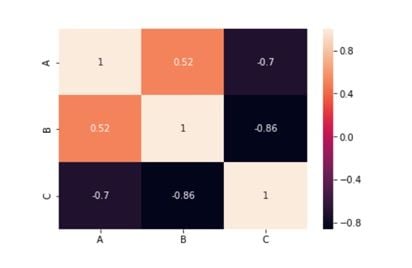
That’s how you can implement a correlation matrix in Python, through which we can get a better understanding about which variables are highly correlated to each other.
Correlation Matrix Applications
- To summarize a large amount of data, in which the goal is to identify patterns. In our example above, the observable pattern is that all the variables highly correlate with each other.
- To input into other analyses. For example, people commonly use the correlation matrix as inputs for exploratory factor analysis, confirmatory factor analysis, structural equation models, and linear regression when excluding missing values pairwise.
- As a diagnostic when checking other analyses. For example, with linear regression, a high number of correlations suggests that the linear regression estimates will be unreliable.
We can use the correlation matrix in the machine learning model to improve accuracy, and we can create a confusion matrix to understand the data.
We can use this statistical technique in the health care sector as well to predict diseases.
Correlation Matrix Advantages
The correlation matrix is a very useful statistical technique by which we can gain a better understanding of our data set and get a summary of it. That way we can analyze the data and make a decision according to it. If you are building any machine learning model, this technique can help you select which data and features will be most impactful. The correlation matrix is the most popular statistical technique, so it has large support and it can easily be implemented in Python or any other programming language.
Frequently Asked Questions
How to analyze a correlation matrix?
In a correlation matrix, each row and column represents a variable, and each cell displays a correlation coefficient. The intersecting cell of each row and column shows the correlation coefficient for those two variables. Each coefficient indicates the strength of the intersecting variables’ relationship (depending on the type of correlation coefficient used).
How do you interpret the values of the correlation matrix?
In a correlation matrix using the Pearson correlation coefficient, a 1 indicates a perfect positive linear correlation between two variables, a 0 indicates no linear correlation and a -1 indicates a perfect negative linear correlation. The closer the number in a matrix cell is to 1, the stronger a positive relationship is of the two associated variables, while a number closer to -1 shows a stronger negative relationship. A number closer to 0 shows a weaker correlation between the two variables.
What is the difference between a correlation and a correlation matrix?
Correlation is the statistical measure of relationship between two or more variables. A correlation matrix is a table showing the correlation coefficients between all possible pairs of variables in a specific data set.





